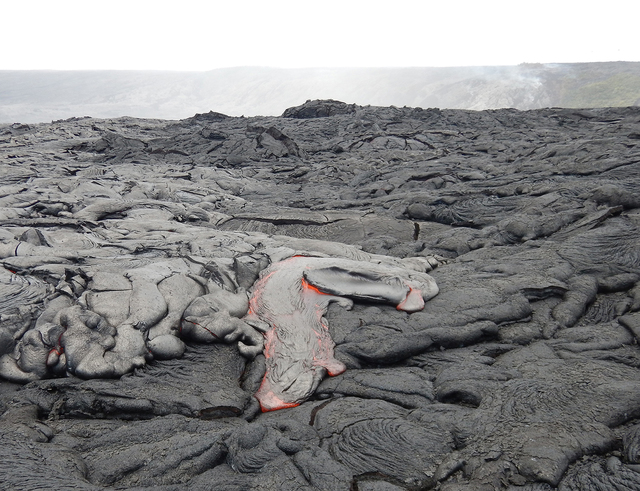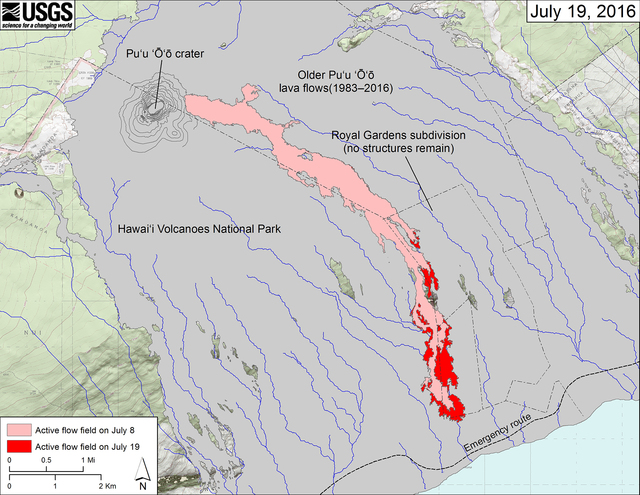What an exciting time for Kilauea volcano-watchers!
What an exciting time for Kilauea volcano-watchers!
Simultaneous eruptions at the summit and along the East Rift Zone of Kilauea might be old news, but a change in late May has created some excitement: a new vent opened on the eastern flank of Puu Oo and is now sending lava down the south flank of Kilauea and across the coastal plain for the first time since 2013.
At Kilauea’s summit, the sloshing, splashing lava lake within the Halemaumau Crater vent has been high enough at times that spatter (bits of molten lava) is occasionally visible from the Jaggar Museum overlook in Hawaii Volcanoes National Park. At night, spectacular views of reddish glow against the dark sky and Milky Way have enthralled visitors.
The new Puu Oo lava flow has been informally named “61g,” as it is the seventh flow (g) in the 61st episode of the ongoing Kilauea East Rift Zone eruption, which began in 1983. The flow now extends roughly 6 miles from the vent, and is advancing to the southeast along the eastern border of Hawaii Volcanoes National Park.
Closer to the vent at Puu Oo, molten lava moves downslope beneath a newly solidified lava surface through a system of lava tubes. It then streams over Pulama pali, a lava-mantled fault scarp, where, at times, the lava produces impressive ‘a’a channels on the steep slopes. On the more gentle gradients of the coastal plain, the flow advances as slower-moving pahoehoe lava lobes and sheets.
The lava flow front remains active, but has made little forward progress toward the ocean in the past two weeks. As of July 20, the flow front remained about 0.4 mile from the emergency road and 0.5 mile from the ocean. A few hundred yards upslope of the flow front, breakouts of pahoehoe lava continue to widen the flow margins.
Visitors hoping to view the flow should consult access and critical safety information before attempting the long hike. Lava-viewing information is available from both the National Park (https://www.nps.gov/havo/planyourvisit/lava2.htm) and Hawaii County (https://www.hawaiicounty.gov/lava-viewing/).
At this point, we cannot say with certainty if or when lava might reach the ocean. If it does, a different set of hazards — from steam explosions to collapsing lava deltas — will impact lava-viewing opportunities. Staying informed will help you stay safe.
Volcano Watch is a weekly article and activity update written by U.S. Geological Survey Hawaiian Volcano Observatory scientists and affiliates.
Volcano Activity Updates:
Mauna Loa is not erupting. The volcano is, however, restless, with rates of deformation and seismicity remaining above long-term background levels. During the past week, small earthquakes occurred beneath the west and north flanks of Mauna Loa, mostly in the 3- to 7-mile depth range. Earthquakes are also occurring in the south caldera and upper Southwest Rift Zone of Mauna Loa at depths less than 3 miles. Global Positioning System measurements show deformation related to inflation of a magma reservoir beneath the summit and upper Southwest Rift Zone, with inflation occurring mainly in the southwestern part of the magma storage complex.
One earthquake was reported felt on Hawaii Island in the past week. On July 15, at 11:11 p.m., HST, a magnitude-2.5 earthquake occurred 4.4 miles southeast of Pahoa at a depth of 1.9 miles.
Visit the HVO website (https://hvo.wr.usgs.gov) for past Volcano Watch articles, volcano updates, photos, maps, and recent earthquake info; call for summary updates at 967-8862 (Kilauea) or 967-8866 (Mauna Loa); email questions to askHVO@usgs.gov.
Volcano Watch is a weekly article and activity update written by U.S. Geological Survey Hawaiian Volcano Observatory scientists and affiliates.


